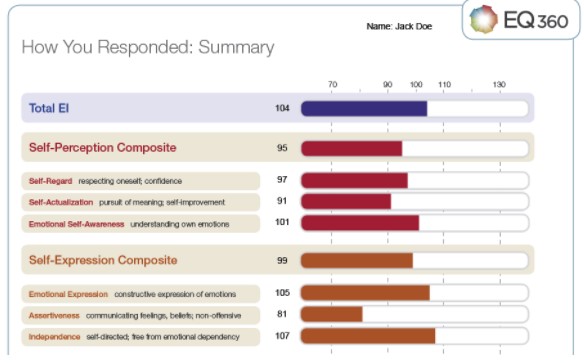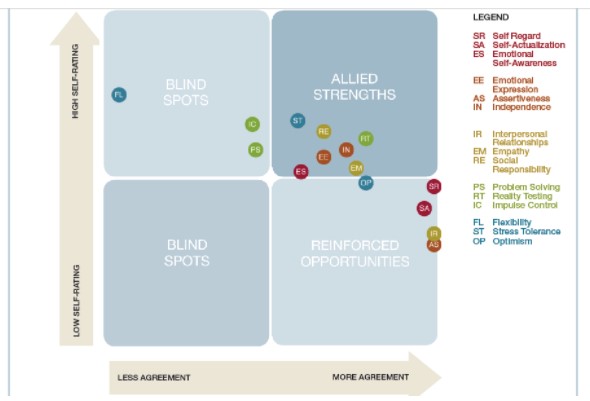The EQ-i 2.0 model of Emotional Intelligence that I’m certified to deliver has the same assessment for all types of different reporting outcomes. You can choose from five different types of reports:
Workplace Report
This report is best for individuals. Despite its name, it is adaptable for anyone at any time.
 This is a common report outcome that shows Self-Perception and Self-Expression results.
This is a common report outcome that shows Self-Perception and Self-Expression results.
The numbers are a standard score that has been adjusted by comparing them to others’ results on the same test. This adjustment allows you to make a comparison between scale scores and makes interpretation possible because you now have a yardstick against which to measure.
As a coach, when I look at these results, I can surmise where the client has areas to improve, however, I cannot decide for my client. I need to conduct a debrief to ascertain what my client’s life’s experiences are and how they’re impacting their current levels of emotional intelligence.
Remember: Your EQ will change according to circumstance and context.
EQ360 Report
This report asks 10+ (the more the better the results will be) of various colleagues, managers and stakeholders to take the assessment about you. Their results are anonymously combined with your results to give you a complete 360-degree analysis of your emotional intelligence.
This is a report outcome that shows where the client’s results correlated with those of their colleagues, managers and other stakeholders in the 360-degree assessment. As you can see, this client has three blind spots they seem unaware of and have room to improve.
Leadership Report
This report combines the Workplace Report through a leadership lens through which to view your EQ-i 2.0 results. There are four general competencies required of most leaders: authenticity, coaching, insight and
innovation.
This is a report outcome that shows Self-Perception and Self-Expression results with someone with high EQ results.
The gold bar positioned on the top of your graph is the Leadership Bar. This bar represents the range of scores of the top leaders (those whose EQ-i 2.0 scores were in the top 50% of the leader sample). Using this bar you can compare your results to those exceptional leaders who demonstrate high EI. If your score falls
near the bottom of the leadership bar, then your EI skills need further development in order to be on par with top leaders. If your score falls near the top of the leadership bar, then your EI skills are as strong as those of top leaders.
With this client, it might be assumed that they have little room for improvement in their EQ because their results are all above average. This would be a mistake because we do not have adequate information about their circumstances or the context of their assessment. The client may still have composites they want to
improve. It could also be that in a different context they would get completely different results. A debrief is essential to learn what the client wants and needs.
EQ360 Leadership Report
This report combines the EQ360 Report and the Leadership Report for a powerful indication of emotional intelligence from multiple perspectives.
EQ Group Report
This report combines the results of the Workplace Report for all team members into one comprehensive report for all members of a team, department, or even a family!
The Debrief Experience
Depending on which report my client has undertaken, I will conduct a 60-90 minute coaching conversation, known as a debrief. These are virtual or in person. I take my clients through their assessment, explaining
the results and discussing what comes next. As a coach, I go with my skills and instinct when I debrief my client’s on their EQ assessments. I elicit from them information that can help them to learn more about themselves to ascertain why they got the results they did and together, we put together a coaching pathway towards increasing the results to a balanced outcome.
Balance is important in the EQ profile because subscales that are higher can be tempered by other related
sub-scales. It all works together to provide an overall picture of the client’s current emotional intelligence.
To learn more about the emotional intelligence assessment, reporting and the debrief experience and how to apply it to your circumstances, book a free 30-minute consultation.

